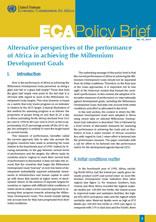ECA Policy Brief - Issue 10

How is the performance of Africa in achieving the Millennium Development Goals perceived as being a glass half full or a glass half empty? Those that hold the glass half empty view point to the fact that it is off-track with regard to most of the Millennium Development Goals targets. This view, however, is based on a metric that only tracks progress on an indicator in relation to the 2015 target. A typical illustration of this method for assessing progress is as follows: the proportion of people living on less than $1.25 a day in Africa (excluding North Africa) declined from 56.5 per cent in 1990 to 48.5 per cent in 2010; as this is approximately 20.25 percentage points off the 2015 target, the subregion is unlikely to meet the target based on current trends.
This measure of performance, hereafter called the current approach, fails to take into account the progress countries have made in achieving the Goals relative to the benchmark year of 1990. Indeed, by focusing exclusively on the gap between current levels of performance and the targets, the efforts made by countries and/or regions to reach their current level of performance is discounted. It does not take into account that the countries that began the Millennium Development Goals “journey” at very low levels of development undoubtedly required substantial investments in infrastructure and human capital to catch up with those that started at higher levels of development. Hence, in the absence of separate targets for countries or regions with difficult initial conditions, it makes sense to adopt a more nuanced approach to assessing their progress towards achieving the Millennium Development Goals. This would include taking into account how far they have progressed from their initial conditions.